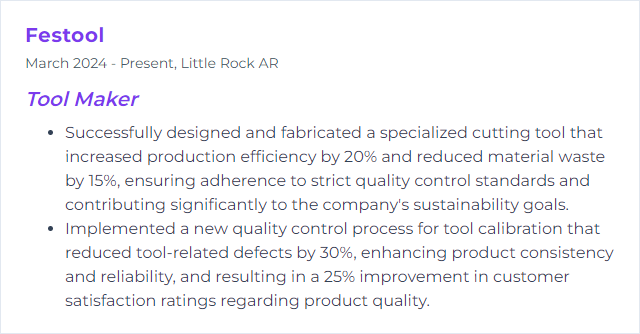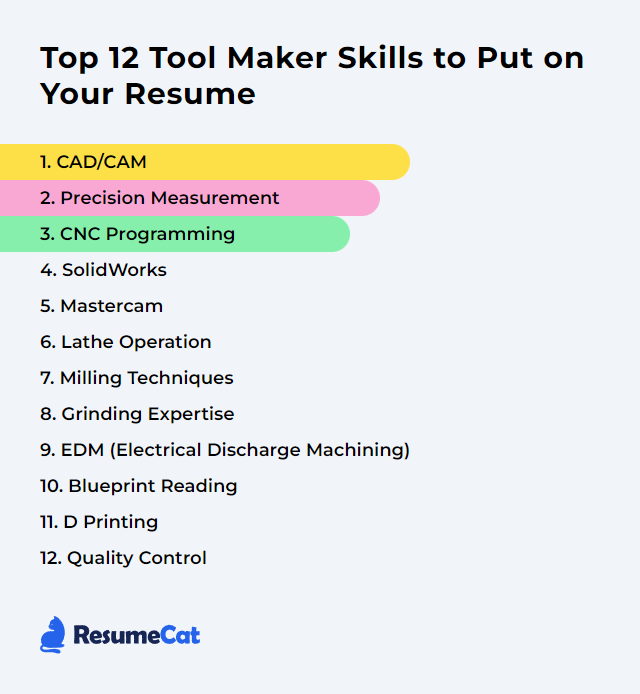Top 12 Tool Maker Skills to Put on Your Resume
In today's highly competitive job market, showcasing the right set of skills on your resume can sharpen your chances of landing a position as a Tool Maker. A concise list of your top capabilities not only shows technical depth, it signals discipline, curiosity, and a habit of building better ways to work.
Tool Maker Skills
- CAD/CAM
- Precision Measurement
- CNC Programming
- SolidWorks
- Mastercam
- Lathe Operation
- Milling Techniques
- Grinding Expertise
- EDM (Electrical Discharge Machining)
- Blueprint Reading
- 3D Printing
- Quality Control
1. CAD/CAM
CAD/CAM stands for Computer-Aided Design and Computer-Aided Manufacturing. It uses software to design parts and then generate the processes to make them. For a Tool Maker, that means precise designs, clean transitions into machining, and fewer surprises on the shop floor.
Why It's Important
CAD/CAM streamlines design through to production. Complex tools and molds become repeatable, edits are faster, and accuracy climbs while lead time shrinks.
How to Improve CAD/CAM Skills
Improving CAD/CAM for a Tool Maker comes down to precision, speed, and tight integration with the shop.
Upgrade Software Regularly: New releases often add toolpath strategies, simulation gains, and stability fixes.
Use Capable Hardware: Fast CPUs, plenty of RAM, and modern GPUs keep large assemblies and simulations snappy.
Integrate Additive: Blend additive for prototypes, inserts, or conformal features that are tough to machine conventionally.
Adopt Simulation: Validate designs and toolpaths to catch collisions, chatter, and deflection before chips fly.
Standardize Data: Set up PDM/PLM to control revisions, templates, post processors, and libraries.
Refine Post Processors: Tune posts to your machines so what you program is what you cut.
Collaborate Early: Designers, programmers, and machinists aligning on constraints up front saves rework later.
How to Display CAD/CAM Skills on Your Resume
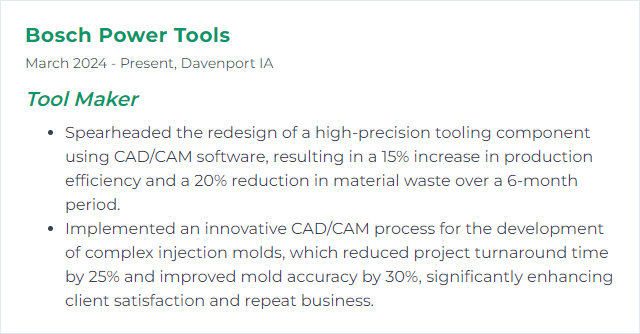
2. Precision Measurement
Precision measurement is the disciplined use of accurate instruments and methods to confirm dimensions, geometry, and surface conditions. It’s how a Tool Maker proves parts meet spec, every time.
Why It's Important
Without precise measurement, tolerance is guesswork. With it, tools fit, assemblies run, and scrap stays low.
How to Improve Precision Measurement Skills
Calibration: Calibrate gauges and instruments on schedule using traceable standards.
Environmental Control: Stabilize temperature and humidity to cut thermal drift. Settle parts before measuring.
Match Tool to Task: Micrometers, bore gauges, height masters, CMMs—choose the right resolution and range.
Training: Practice proper technique: feel, alignment, cosine error avoidance, and uncertainty basics.
Fixtures and Jigs: Fixturing kills variability. Measure from stable, repeatable datums.
Minimize Handling: Gloves, clean benches, and careful sequencing reduce contamination and distortion.
Digital Data: Use instruments with output for automatic logging and SPC.
Maintenance: Clean, protect, and store instruments properly to preserve accuracy.
How to Display Precision Measurement Skills on Your Resume
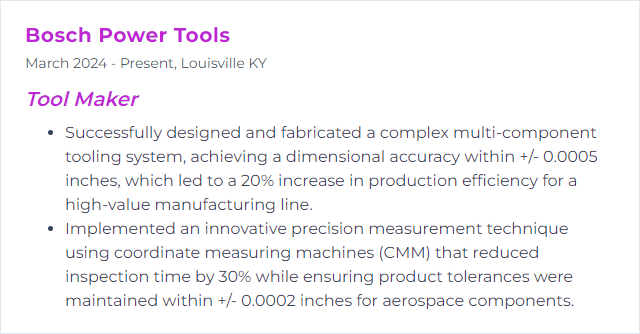
3. CNC Programming
CNC programming creates the code that drives machine motion and process logic. For Tool Makers, it’s where toolpath strategy, tool selection, and tolerance control meet the realities of metal cutting.
Why It's Important
It unlocks accuracy, repeatability, and throughput. Complex geometry becomes practical, predictable, and fast.
How to Improve CNC Programming Skills
Nail the Fundamentals: G/M codes, work offsets, cutter comp, macros, probing cycles—know them cold.
Exploit CAD/CAM: Learn advanced roughing, rest machining, and finishing strategies that protect tools and time.
Optimize Toolpaths: High-efficiency milling, constant engagement, and smooth linking reduce heat and wear.
Simulate: Full machine simulation catches crashes, overtravel, and gouges before they’re expensive.
Tune Feeds/Speeds: Use calculators and shop trials to dial in chip load by material and tool geometry.
Keep Learning: Courses on modern CAM, 5-axis, and automation from reputable training providers (including LinkedIn Learning) keep you current.
How to Display CNC Programming Skills on Your Resume

4. SolidWorks
SolidWorks is a 3D CAD platform used to model, analyze, and prepare tooling for manufacture. It turns ideas into manufacturable geometry with clarity and control.
Why It's Important
Fast iteration, design intent captured in sketches and features, and mold tools that fit and function—SolidWorks helps you deliver all three.
How to Improve SolidWorks Skills
Sketching and Part Modeling: Constrain wisely, define intent, avoid overbuilding. Clean sketches lead to stable models.
Assemblies: Lightweight modes, configurations, and mates that don’t fight you—build for performance.
Surface Modeling: Blend, patch, and control curvature for complex tooling faces and clean splits.
Mold Tools: Use tooling split, parting lines, draft analysis, and shutoffs to accelerate mold design.
SolidWorks CAM: Bring manufacturability upstream with feature recognition and early toolpath checks.
Customization: Templates, design tables, macros, and hotkeys shaped to your workflow save hours.
Stay Current: New release features compound over time—review what’s new and apply it on real parts.
How to Display SolidWorks Skills on Your Resume

5. Mastercam
Mastercam is CAM software widely used for milling, turning, and multi-axis toolpaths. Tool Makers lean on it to generate efficient, safe code for molds, dies, fixtures, and precision components.
Why It's Important
It connects design to metal with advanced strategies, robust simulation, and libraries that reflect the tooling you actually own.
How to Improve Mastercam Skills
Take Official Training: Mastercam University and certified partners offer structured learning paths.
Practice Deliberately: Build small projects that isolate one concept—rest roughing, multi-axis deburr, dynamic motion.
Engage the Community: User groups and forums surface post tweaks, toolpath tricks, and troubleshooting patterns.
Stay Updated: New releases add toolpaths, verification improvements, and tooling support—adopt what helps your parts.
Study Current Guides: Modern “Mill 3D” and multi-axis texts and courses give practical, shop-ready workflows.
Leverage Libraries: Curate posts, holders, tool assemblies, and defaults that mirror your machines.
How to Display Mastercam Skills on Your Resume

6. Lathe Operation
Lathe operation means turning raw stock into precise cylindrical features—faces, bores, threads, tapers—through controlled rotation and cutting.
Why It's Important
Much of tooling relies on round, concentric, dead-straight geometry. A lathe makes that possible, repeatably.
How to Improve Lathe Operation Skills
Right Tooling: Match insert geometry and grade to material, chipbreaker to cut style, holder to rigidity.
Keep It Sharp: Inspect edges, index timely, and track tool life so finishes stay crisp.
Dial Parameters: Tune surface speed, feed per rev, and depth of cut. Use calculators, then validate on the machine.
Coolant and Lube: Apply appropriately—flood for heavy cuts, mist or oil where needed; keep it clean.
Minimize Overhang: Short, rigid setups beat chatter. Support with tailstock or steadies when length demands it.
Alignment Matters: Indicate chucks and tailstocks, square tools, verify runout—tiny errors snowball.
Measure In-Process: Check diameters, tapers, and threads during the cut plan, not after it’s too late.
How to Display Lathe Operation Skills on Your Resume

7. Milling Techniques
Milling shapes parts with rotating cutters to carve slots, pockets, contours, and surfaces. Face milling, peripheral milling, and end milling each have a place; the craft lies in choosing the right one and feeding it properly.
Why It's Important
Great milling means accurate geometry, better finishes, and less time spent sanding, polishing, or reworking.
How to Improve Milling Techniques Skills
Optimize Parameters: Set cutting speed, chip load, and stepdowns to balance tool life and MRR. Adjust by material and tool engagement.
Choose the Right Tool: Coatings, flute count, corner radii, and reach all matter. Match them to the job.
Smarter Toolpaths: High efficiency strategies, trochoidal moves, and smooth arcs reduce heat and deflection.
Coolant Strategy: Aim, pressure, and type affect chip evacuation and finish. Keep coolant filtered and stable.
Machine Health: Backlash, way lube, spindle condition, and tram all influence accuracy—maintain them.
Rigidity: Solid workholding and balanced tool assemblies cut chatter and improve surface quality.
How to Display Milling Techniques Skills on Your Resume

8. Grinding Expertise
Grinding expertise is the ability to shape, sharpen, and finish with abrasive processes. Tight tolerances, mirror finishes, and geometry that holds under inspection—this is where grinding shines.
Why It's Important
It’s often the last touch before delivery. Precision here determines tool life, performance, and how parts assemble downstream.
How to Improve Grinding Expertise Skills
Know the Fundamentals: Wheel types, bonds, grit sizes, and dressing methods—master the cause and effect.
Balance and Dress: Well-balanced spindles and correctly dressed wheels make finishes pop and heat drop.
Control Heat: Apply coolant effectively, manage dwell, and avoid burn. Measure and mitigate thermal growth.
Fixture Rigidly: Secure parts against micro-movement; use stable, clean datums.
Surface Integrity: Monitor for microcracks and residual stress; adjust parameters to protect the material.
Document Settings: Log wheel wear, feeds, and results to build recipes you trust.
Safety First: Wheel handling, ring tests, guards, PPE—treat grinding with respect.
How to Display Grinding Expertise Skills on Your Resume
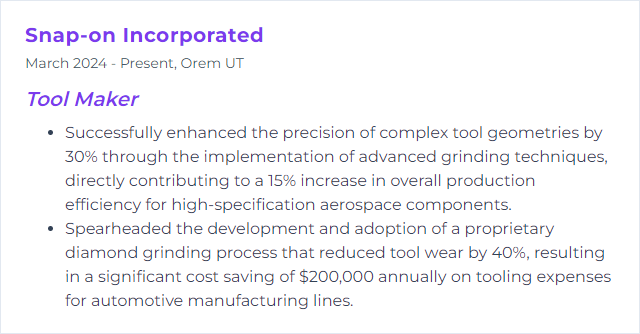
9. EDM (Electrical Discharge Machining)
EDM removes material with controlled electrical sparks. Intricate cavities, hard alloys, fine details—EDM cuts what conventional tools can’t easily reach.
Why It's Important
It enables precise geometry in tough materials, with minimal mechanical stress and excellent repeatability.
How to Improve EDM (Electrical Discharge Machining) Skills
Parameter Control: Tune pulse on/off time, peak current, and voltage to balance speed, wear, and finish.
Electrode Strategy: Choose materials (graphite, copper, copper-tungsten) and design electrodes for rigidity, flushing, and wear compensation.
Dielectric Health: Keep filters fresh, fluid clean, and flushing effective to stabilize spark conditions.
Precision Fixturing: Use repeatable datums and probing to reduce setup drift and stack-up.
Hybrid Workflow: Pair EDM with hard milling and polishing where it shortens total cycle time.
Preventive Maintenance: Maintain guides, power supplies, and wire path components for consistent results.
How to Display EDM (Electrical Discharge Machining) Skills on Your Resume
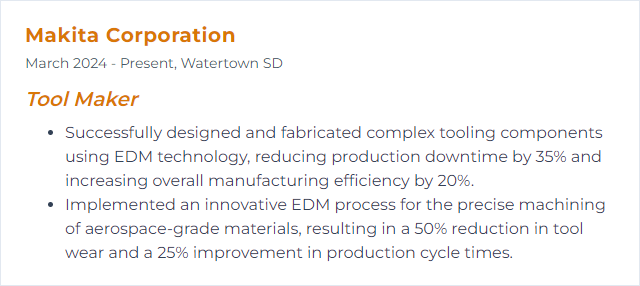
10. Blueprint Reading
Blueprint reading is the art of translating drawings into real parts. Dimensions, tolerances, materials, finishes, notes, and sequences—read them, question them, and follow them.
Why It's Important
It’s the contract between design and manufacture. Misread a callout and everything downstream suffers.
How to Improve Blueprint Reading Skills
Master the Basics: Scales, line types, sections, and views—build your foundation.
GD&T Fluency: Datums, position, profile, runout, flatness—apply tolerances the way they were intended.
Practice on Real Prints: Use past jobs and sample packets. Verify your interpretations at the CMM or bench.
Ask and Confirm: Clarify ambiguous notes early. Document assumptions when time is tight.
Stay Current: Track updates to standards and common shop conventions so your interpretations remain aligned.
How to Display Blueprint Reading Skills on Your Resume

11. 3D Printing
3D printing creates physical parts from digital models by building up material layer by layer. For a Tool Maker, it accelerates prototypes, custom fixtures, jigs, soft tooling, and even production inserts.
Why It's Important
Fast iterations, complex internal features, and tailored ergonomics—delivered without the time sink of traditional setups.
How to Improve 3D Printing Skills
Chase Precision: Calibrate axes, extruders, lasers, or resin exposure. Use high-resolution profiles for critical fits.
Material Mastery: Match filaments, resins, or powders to mechanical and thermal needs. Read datasheets and test coupons.
Optimize Workflow: Tweak slicer settings for strength, speed, and surface. Orient for strength; support for removal; post-process for finish.
How to Display 3D Printing Skills on Your Resume
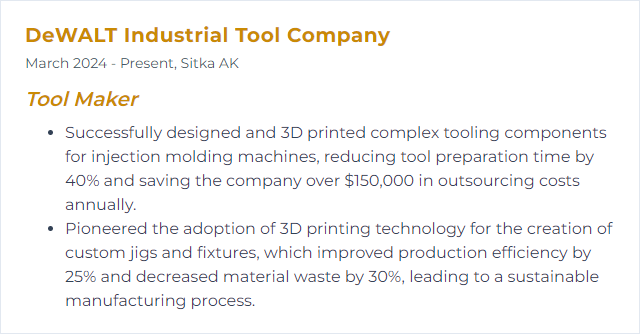
12. Quality Control
Quality control is the system that guards specs from concept to shipment. Plan it, measure it, review it—then improve it.
Why It's Important
It keeps nonconformances rare, customers happy, and rework from eroding margins.
How to Improve Quality Control Skills
Standardize: Build procedures that align with ISO 9001-style quality management and keep them living documents.
Train Often: Refresh measurement methods, gauge R&R, and process control so everyone reads the same playbook.
Lean Thinking: Remove waste, shorten changeovers, and stabilize processes—quality improves as variation drops.
Use the Right Equipment: Invest in accurate instruments and maintain them. Confidence comes from capability.
Inspect with Purpose: First-article, in-process, and final checks tied to risk and tolerance stack-ups.
Close the Loop: Feed back customer and internal findings into corrective and preventive actions.
Digitize Data: SPC dashboards, traceability, and clear records speed decisions and audits.
How to Display Quality Control Skills on Your Resume
